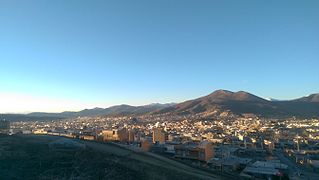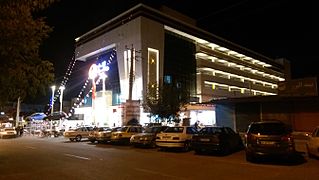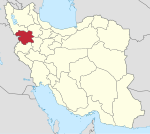Baneh

Baneh Persian: بانه | |
|---|---|
City | |
 Panorama view of Baneh | |
| Coordinates: 35°59′49″N 45°53′07″E / 35.99694°N 45.88528°E[1] | |
| Country | Iran |
| Province | Kurdistan |
| County | Baneh |
| District | Central |
| Area | |
| • Total | 1,584.5 km2 (611.8 sq mi) |
| Elevation | 1,554 m (5,098 ft) |
| Population (2016)[2] | |
| • Total | 110,218 |
| • Density | 70/km2 (180/sq mi) |
| Time zone | UTC+3:30 (IRST) |
| Area code | 087-342 |
| Website | www |
Baneh (Persian: بانه)[a] is a city in the Central District of Baneh County, Kurdistan province, Iran, serving as capital of both the county and the district.[6] Baneh is approximately 30 km (18 miles) from Kurdistan Region in Iraq.
History
Historically, Baneh had a strategic and political importance due to its close proximity to the Ottoman Empire. The city was part of the three Kurdish principalities; Ardalan, Baban and Mokryan.[7]
The old city had two citadels and was generally ruled by the Eḵtīār-al-Dīn family who held both religious and secular power of the city. The family was held in high esteem during the Safavid era and received the title 'sultan'. Moreover, rulers of Baneh had the responsibility of protecting the whole area from Khoy to Kermanshah. In the 16th century, Mīrzā Beg b. Mīr Moḥammad became the first virtually independent ruler of Baneh and its surroundings.[7]
During the 18th and 19th centuries, the city was plagued with epidemics which killed a large portion of the population. In 1944, the city experienced turmoil as part of the Hama Rashid revolt and was also bombed by both parties during the Iran–Iraq War in the 1980s. Most locals fled to Iraq during the war and much of the region was destroyed.[7]
Demographics
Language and ethnicity
The population is mostly Shafiʽi Kurdish who speak Sorani.[7]
Population
At the time of the 2006 National Census, the city's population was 69,635 in 15,857 households.[8] The following census in 2011 counted 85,190 people in 22,149 households.[9] The 2016 census measured the population of the city as 110,218 people in 30,743 households.[2] After the cities of Sanandaj, Saqqez and Marivan, Baneh is the fourth most populous city in Kurdistan province.[citation needed]
Notable people
- Ebrahim Younesi, writer and translator
- Bahman Ghobadi, director and writer
- Ata Nahaei, novelist and translator
- Ebrahim Alipour, photographer
- Keywan Karimi, director
Gallery
- View of the city from Dokanan Park
- View of Arbaba on a winter's day
- Baneh by day
- Shahr Park in spring
- Haleh International 5-Star hotel
- Behesht Shopping Center
- Aftab Derakhshan shopping center
- Sooren plain and forest
- Arbaba forest
- Snow covered Kali Khan
![]() Media related to Baneh at Wikimedia Commons
Media related to Baneh at Wikimedia Commons
Notes
References
- ^ OpenStreetMap contributors (16 August 2023). "Baneh, Baneh County" (Map). OpenStreetMap (in Persian). Retrieved 16 August 2023.
- ^ a b "Census of the Islamic Republic of Iran, 1395 (2016)". AMAR (in Persian). The Statistical Center of Iran. p. 12. Archived from the original (Excel) on 8 May 2022. Retrieved 19 December 2022.
- ^ Baneh can be found at GEOnet Names Server, at this link, by opening the Advanced Search box, entering "-3055216" in the "Unique Feature Id" form, and clicking on "Search Database".
- ^ "ئێوەش پشتیوانی ماڵی ڕێکخراوی مافی مرۆڤیی"هەنگاو" بن" (in Kurdish). Retrieved 21 March 2020.
- ^ "Hengaw- Li devera Bane ya Rojhilatê Kurdistanê kolberekî kurd di encama êrişa pasdarên Îranê de hat kuştin" (in Kurdish). Retrieved 21 March 2020.
- ^ Habibi, Hassan (21 June 1369). "Approval of the organization and chain of citizenship of the elements and units of the national divisions of Kurdistan province, centered in the city of Sanandaj". Islamic Parliament Research Center of the Islamic Republic of Iran (in Persian). Ministry of Interior, Defense Political Commission of the Government Board. Archived from the original on 23 October 2018. Retrieved 22 January 2024.
- ^ a b c d Marduk, A. (1988). "BĀNA". Encyclopedia Iranica.
- ^ "Census of the Islamic Republic of Iran, 1385 (2006)". AMAR (in Persian). The Statistical Center of Iran. p. 12. Archived from the original (Excel) on 20 September 2011. Retrieved 25 September 2022.
- ^ "Census of the Islamic Republic of Iran, 1390 (2011)". Syracuse University (in Persian). The Statistical Center of Iran. p. 12. Archived from the original (Excel) on 19 January 2023. Retrieved 19 December 2022.












